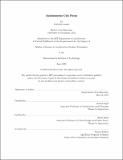Autonomous city form
Author(s)
Kryvozub, Pavlo.
Download1135858050-MIT.pdf (93.83Mb)
Other Contributors
Massachusetts Institute of Technology. Department of Architecture.
Advisor
Rafael Segal and Brent Ryan.
Terms of use
Metadata
Show full item recordAbstract
Innovations in transportation give us a chance to rethink and redefine the art of city design, centered as much on the quality of public space as on economic efficiency. Transportation is the backbone of urbanism. What is a city if not a group of buildings distributed in space and thus functioning together. Historically, innovations in transportation challenged the temporal and spatial qualities of the city. The automobile expanded the city in breadth. The elevator built it up in height. However, with the expansion of the city size, density and prosperity, we have sacrificed public domain, and worsened of the quality of the urban form. This thesis looks into the relationships between transportation technology as a driver and space as a medium of urban design. With the rapid introduction of new technologies in transportation (autonomous vehicles) there is an opportunity to rethink the aesthetics of the urban form and its perception. Through design research, this thesis seeks to synthesize principles of spatial design and propose potential alternatives to the future of urbanism. Keywords: Aesthetic urbanism, Perception of space, Autonomous Transportation
Description
This electronic version was submitted by the student author. The certified thesis is available in the Institute Archives and Special Collections. Thesis: S.M. in Architecture Studies (Urbanism), Massachusetts Institute of Technology, Department of Architecture, 2019 Cataloged from PDF version of thesis. Includes bibliographical references (pages 104-105).
Date issued
2019Department
Massachusetts Institute of Technology. Department of ArchitecturePublisher
Massachusetts Institute of Technology
Keywords
Architecture.